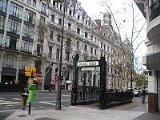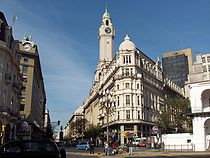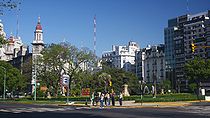
Montserrat, Buenos Aires
Encyclopedia
Monserrat is a neighbourhood located in the east of the Buenos Aires CBD
. The district features some of the most important public buildings in Buenos Aires, including city hall, the city legislature, Casa Rosada
, the Colegio Nacional de Buenos Aires
and the Libertador Building
(Ministry of Defense), among others.

 Avenida de Mayo
Avenida de Mayo
runs through the Monserrat district, connecting Plaza de Mayo
and the Plaza de los Dos Congresos (Congressional Plaza).
A block, or two, south of the Plaza de Mayo, the older section of Monserrat begins. This is Buenos Aires' oldest neighborhood and even today, very little of the cityscape there is less than a hundred years old (except along Belgrano Avenue), thereby making a nearly seamless transition to the likewise historic San Telmo
district, to the south.
Juan de Garay
disembarked on the area's shores. The Fort of Juan Baltazar of Austria, the marginal settlement's first, was built in 1594 and, in 1608, newly arrived Jesuits were granted a 2-hectare (5 acre) lot, nearby. The Jesuits began work on the Parish of St. Ignatius of Loyola in 1686. Consecrated in 1734, it is the oldest existing church in Buenos Aires. Possessing the finest school and library at the time and offering colonial Buenos Aires' only truly classical education there, their property became popularly known as the "Illuminated Block
." The small city's growing population led to the introduction of a number of other religious orders in this area, notably the Catalan Brotherhood of the Virgin of Monserrat, whose chapel became the neighborhood namesake in 1769. The Cabildo
(City hall) became the scene of the 1810 pronouncements
in favor of autonomy that later led to independence and, to commemorate the fact, in 1811 the iconic May Pyramid was placed in what later became the Plaza de Mayo
.
Little changed over the next seventy years, Monserrat's muddy shore and typically colonial grid of cobblestone streets came under a rapid modernization following Argentina's sudden economic development after 1875. Land reclamation and the creation of docks parallel to the area led to the construction of Paseo Colón (still a major thoroughfare) along Monserrat's eastern edge. The area's two adjoining squares became the Plaza de Mayo
in 1884, a milestone joined by the completion of the presidential executive building, the Casa Rosada
. This was followed by the massive razing of colonial architecture (including part of the Cabildo) to make way for the Avenida de Mayo
, opened in 1894 and Congressional Plaza
, in 1910. The avenue became home to the Buenos Aires Metro
's first stations, in 1913.
The area's led central location and its presence therein of much of Argentina's governmental structure led to monumental construction over the next twenty years, notable among which are the Buenos Aires City Legislature
, the Customs building
, the offices of La Prensa
(today the Buenos Aires House of Culture
), the art-deco NH City Hotel (off the Plaza de Mayo), the Ministry of Defense and South Diagonal Avenue. Monserrat's western half was partitioned from the rest by the southward expansion of the massive Nueve de Julio Avenue around 1950 and, partial to trendy high-rises, much of Monserrat's middle class and commercial office space market left, afterwards. The area became a largely bohemian quarter popular with tango
performers and artists, as well as many who preferred the area's close proximity to the growing financial district
to the north and its relatively low rent scale. Its rich architectural history and quaint, narrow streets have, as in neighboring San Telmo
, helped lead to renewed interest in Monserrat since around 1990, a change highlighted by the 1993 opening of the high-rise InterContinental Hotel. The area's numerous Spanish restaurants and social clubs belonging to Buenos Aires' large Spaniard
community have long associated Monserrat with local Spanish tradition, helping make it attractive to tourism for cultural reasons, as well as those of ambience.
Buenos Aires Central Business District
The Buenos Aires central business district , is the main commercial centre of Buenos Aires, Argentina, though not an official city ward.-Overview:...
. The district features some of the most important public buildings in Buenos Aires, including city hall, the city legislature, Casa Rosada
Casa Rosada
La Casa Rosada is the official seat of the executive branch of the government of Argentina, and of the offices of the President. The President normally lives at the Quinta de Olivos, a compound in Olivos, Buenos Aires Province. Its characteristic color is pink, and is considered one of the most...
, the Colegio Nacional de Buenos Aires
Colegio Nacional de Buenos Aires
Colegio Nacional de Buenos Aires is a public high school in Buenos Aires, Argentina. In the tradition of the European gymnasium it provides a free education that includes classical languages such as Latin and Greek. The school is one of the most prestigious in Argentina...
and the Libertador Building
Libertador Building
The Libertador Building is a government building in Buenos Aires, Argentina, housing the Ministry of Defense.-Overview:...
(Ministry of Defense), among others.


Avenida de Mayo
Avenida de Mayo , is an avenue in Buenos Aires, capital of Argentina. It connects the Plaza de Mayo with Congressional Plaza, and extends in a west-east direction before merging into Avenida Rivadavia.-History and overview:...
runs through the Monserrat district, connecting Plaza de Mayo
Plaza de Mayo
The Plaza de Mayo is the main square in downtown Buenos Aires, Argentina. It is flanked by Hipólito Yrigoyen, Balcarce, Rivadavia and Bolívar streets....
and the Plaza de los Dos Congresos (Congressional Plaza).
A block, or two, south of the Plaza de Mayo, the older section of Monserrat begins. This is Buenos Aires' oldest neighborhood and even today, very little of the cityscape there is less than a hundred years old (except along Belgrano Avenue), thereby making a nearly seamless transition to the likewise historic San Telmo
San Telmo
San Telmo is the oldest barrio of Buenos Aires, Argentina. It is a well-preserved area of the Argentine metropolis and is characterized by its colonial buildings. Cafes, tango parlors and antique shops line the cobblestone streets, which are often filled with artists and dancers.San Telmo's...
district, to the south.
History
The Monserrat area traces its origins to the foundation of Buenos Aires itself, when, in 1580, Spanish AdelantadoAdelantado
Adelantado was a military title held by some Spanish conquistadores of the 15th, 16th and 17th centuries.Adelantados were granted directly by the Monarch the right to become governors and justices of a specific region, which they charged with conquering, in exchange for funding and organizing the...
Juan de Garay
Juan de Garay
Juan de Garay was a Spanish conquistador.Garay was born in Orduña, Spain. He served under the Spanish crown, in the Viceroyalty of Peru...
disembarked on the area's shores. The Fort of Juan Baltazar of Austria, the marginal settlement's first, was built in 1594 and, in 1608, newly arrived Jesuits were granted a 2-hectare (5 acre) lot, nearby. The Jesuits began work on the Parish of St. Ignatius of Loyola in 1686. Consecrated in 1734, it is the oldest existing church in Buenos Aires. Possessing the finest school and library at the time and offering colonial Buenos Aires' only truly classical education there, their property became popularly known as the "Illuminated Block
Illuminated Block
The Illuminated Block is a historical landmark in the Monserrat neighbourhood of Buenos Aires, Argentina.-History:The Society of Jesus arrived in the newly-founded village of Buenos Ayres in 1608, establishing their first mission on a 2 hectare lot which had earlier been aside by Spanish...
." The small city's growing population led to the introduction of a number of other religious orders in this area, notably the Catalan Brotherhood of the Virgin of Monserrat, whose chapel became the neighborhood namesake in 1769. The Cabildo
Buenos Aires Cabildo
The Buenos Aires Cabildo is the public building in Buenos Aires that was used as seat of the ayuntamiento during the colonial times and the government house of the Viceroyalty of the Río de la Plata...
(City hall) became the scene of the 1810 pronouncements
May Revolution
The May Revolution was a week-long series of events that took place from May 18 to 25, 1810, in Buenos Aires, capital of the Viceroyalty of the Río de la Plata, a Spanish colony that included roughly the territories of present-day Argentina, Bolivia, Paraguay and Uruguay...
in favor of autonomy that later led to independence and, to commemorate the fact, in 1811 the iconic May Pyramid was placed in what later became the Plaza de Mayo
Plaza de Mayo
The Plaza de Mayo is the main square in downtown Buenos Aires, Argentina. It is flanked by Hipólito Yrigoyen, Balcarce, Rivadavia and Bolívar streets....
.
Little changed over the next seventy years, Monserrat's muddy shore and typically colonial grid of cobblestone streets came under a rapid modernization following Argentina's sudden economic development after 1875. Land reclamation and the creation of docks parallel to the area led to the construction of Paseo Colón (still a major thoroughfare) along Monserrat's eastern edge. The area's two adjoining squares became the Plaza de Mayo
Plaza de Mayo
The Plaza de Mayo is the main square in downtown Buenos Aires, Argentina. It is flanked by Hipólito Yrigoyen, Balcarce, Rivadavia and Bolívar streets....
in 1884, a milestone joined by the completion of the presidential executive building, the Casa Rosada
Casa Rosada
La Casa Rosada is the official seat of the executive branch of the government of Argentina, and of the offices of the President. The President normally lives at the Quinta de Olivos, a compound in Olivos, Buenos Aires Province. Its characteristic color is pink, and is considered one of the most...
. This was followed by the massive razing of colonial architecture (including part of the Cabildo) to make way for the Avenida de Mayo
Avenida de Mayo
Avenida de Mayo , is an avenue in Buenos Aires, capital of Argentina. It connects the Plaza de Mayo with Congressional Plaza, and extends in a west-east direction before merging into Avenida Rivadavia.-History and overview:...
, opened in 1894 and Congressional Plaza
Congressional Plaza
Congressional Plaza is a public park facing the Argentine Congress in Buenos Aires. The plaza is part of a 3 hectare open space comprising three adjoining plazas to the east of the Congress building...
, in 1910. The avenue became home to the Buenos Aires Metro
Buenos Aires Metro
The Buenos Aires Metro , locally known as Subte is a mass-transit system that serves the city of Buenos Aires, Argentina. The first station of this network opened in 1913, the first of its kind in South America, the Southern Hemisphere and the entire Spanish-speaking world...
's first stations, in 1913.
The area's led central location and its presence therein of much of Argentina's governmental structure led to monumental construction over the next twenty years, notable among which are the Buenos Aires City Legislature
Buenos Aires City Legislature
The Buenos Aires City Legislature is a central part of the Government of the City of Buenos Aires, as well as an architectural landmark in the city's Montserrat section.-History:...
, the Customs building
Buenos Aires Customs
The Buenos Aires Customs House is a government building and architectural landmark in the Montserrat section of Buenos Aires.-Overview:...
, the offices of La Prensa
La Prensa (Buenos Aires)
La Prensa is an Argentine daily newspaper.Based in Buenos Aires, it was founded on 18 October 1869 by José C. Paz. La Prensa ranked among the most widely circulated dailies in Argentina in subsequent decades, earning a reputation for conservatism and support for British interests in Argentina...
(today the Buenos Aires House of Culture
Buenos Aires House of Culture
The Buenos Aires House of Culture is an architectural landmark in the Montserrat section of the Argentine capital.-Overview:The outmoded headquarters of what was then Argentina's second-largest newspaper, La Prensa, led its influential proprietor in 1894, José Clemente Paz, to purchase a 1300 m² ...
), the art-deco NH City Hotel (off the Plaza de Mayo), the Ministry of Defense and South Diagonal Avenue. Monserrat's western half was partitioned from the rest by the southward expansion of the massive Nueve de Julio Avenue around 1950 and, partial to trendy high-rises, much of Monserrat's middle class and commercial office space market left, afterwards. The area became a largely bohemian quarter popular with tango
Argentine tango
Argentine tango is a musical genre of simple quadruple metre and binary musical form, and the social dance that accompanies it. Its lyrics and music are marked by nostalgia, expressed through melodic instruments including the bandoneon. Originated at the ending of the 19th century in the suburbs of...
performers and artists, as well as many who preferred the area's close proximity to the growing financial district
San Nicolás, Buenos Aires
San Nicolás is one of the neighbourhoods of the city of Buenos Aires, Argentina, sharing most of the city and national government structure with neighboring Montserrat and home to much of Buenos Aires' financial sector...
to the north and its relatively low rent scale. Its rich architectural history and quaint, narrow streets have, as in neighboring San Telmo
San Telmo
San Telmo is the oldest barrio of Buenos Aires, Argentina. It is a well-preserved area of the Argentine metropolis and is characterized by its colonial buildings. Cafes, tango parlors and antique shops line the cobblestone streets, which are often filled with artists and dancers.San Telmo's...
, helped lead to renewed interest in Monserrat since around 1990, a change highlighted by the 1993 opening of the high-rise InterContinental Hotel. The area's numerous Spanish restaurants and social clubs belonging to Buenos Aires' large Spaniard
Spanish Argentine
Spanish settlement in Argentina, that is the arrival of Spanish emigrants in Argentina, took place firstly in the period before Argentina's independence from Spain, and again in large numbers during the late 19th and early 20th centuries...
community have long associated Monserrat with local Spanish tradition, helping make it attractive to tourism for cultural reasons, as well as those of ambience.

